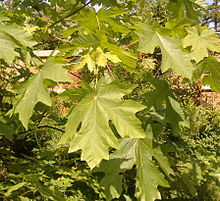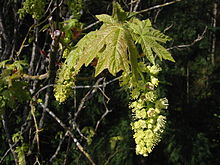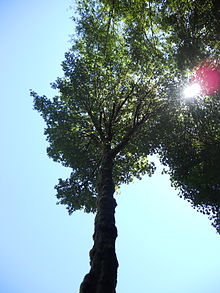- Acer macrophyllum
-
Acer macrophyllum 
Bigleaf Maple foliage Conservation status Scientific classification Kingdom: Plantae (unranked): Angiosperms (unranked): Eudicots (unranked): Rosids Order: Sapindales Family: Sapindaceae[1] Genus: Acer Species: A. macrophyllum Binomial name Acer macrophyllum
PurshAcer macrophyllum (Bigleaf Maple or Oregon Maple) is a large deciduous tree in the genus Acer.
It can grow to be up to 35 m tall, but more commonly grows 15 m to 20 m tall. It is native to western North America, mostly near the Pacific coast, from southernmost Alaska to southern California. Some stands are also found inland in the foothills of the Sierra Nevada mountains of central California, and a tiny population occurs in central Idaho.[2][3]
Contents
Description
It has the largest leaves of any maple, typically 15–30 cm across, with five deeply-incised palmate lobes, with the largest running to 61 cm.
The flowers are produced in spring in pendulous racemes 10–15 cm long, greenish-yellow with inconspicuous petals. The fruit is a paired winged samara, each seed 1-1.5 cm diameter with a 4–5 cm wing.[2][3]
In the more humid parts of its range, as in the Olympic National Park, its bark is covered with epiphytic moss and fern species.
Habitat
Bigleaf maple can form pure stands on moist soils in proximity to streams, but are generally found within riparian hardwood forests or dispersed, (under or within), relatively open canopies of conifers, mixed evergreens, or oaks (Quercus spp.).[4] In cool and moist temperate mixed woods they are one of the dominant species.[5]
Uses
Lumber
Bigleaf maple is the only commercially important maple of the Pacific Coast region.[4]
The wood is used for applications as diverse as furniture, piano frames and salad bowls. Highly figured wood is not uncommon and is used for veneer, stringed instruments and guitar bodies.
The wood is primarily used in veneer production for furniture, but is also used in musical instrument production, interior paneling, and other hardwood products; the heartwood is light, reddish-brown, fine-grained, moderately heavy, and moderately hard and strong [6] Lakwungen First Nations people of Vancouver Island call it the Paddle Tree and used it to make paddles and spindle wheels[citation needed].
In California, land managers do not highly value Bigleaf, and it is often intentionally knocked over and left un-harvested during harvest of Douglas Fir and redwood stands.[7]
Food
Maple syrup has been made from the sap of Bigleaf Maple trees.[8] While the sugar concentration is about the same as in Acer saccharum (sugar maple), the flavor is somewhat different. Interest in commercially producing syrup from Bigleaf Maple sap has been limited.[9] Although not traditionally used for syrup production, it takes about 132 L (35 gal.) of sap to produce 3.8 L (1 gal.) of maple syrup.
Bigleaf is used as browse by black-tailed deer, mule deer, and horses during the sapling stage.[10] A western Oregon study found that 60 percent of bigleaf maple seedlings over 10 inches (25 cm) tall had been browsed by deer, most several times.[11]
Big Tree
The current national champion Bigleaf Maple is located in Marion, Oregon. It has a circumference of 305 inches (or a average diameter at breast height of about 8 feet 1 inch), is 88 feet tall, and has a crown spread of 104 feet.[12]
References
- ^ Stevens, P. F. (2001 onwards). Angiosperm Phylogeny Website. Version 9, June 2008 [and more or less continuously updated since]. http://www.mobot.org/MOBOT/research/APweb/.
- ^ a b Plants of British Columbia: Acer macrophyllum
- ^ a b Jepson Flora: Acer macrophyllum
- ^ a b US Forest Service
- ^ [1]
- ^ Arno, Stephen F.; Hammerly, Ramona P. 1977. Northwest trees. Seattle, WA: The Mountaineers. 222 p. [4208]
- ^ Bolsinger, Charles L. 1988. The hardwoods of California's timberlands, woodlands, and savannas. Resour. Bull. PNW-RB-148. Portland, OR: U.S.Department of Agriculture, Forest Service, Pacific Northwest Research Station. 148 p. [5291]
- ^ Ruth, Robert H.; Underwood, J. Clyde; Smith, Clark E.; Yang, Hoya Y. 1972. Maple sirup production from bigleaf maple. PNW-181. Portland, OR: U.S. Department of Agriculture, Forest Service, Pacific Northwest Forest and Range Experiment Station. 12 p. [8592] (pdf file)
- ^ Island Net: Maple syrup (pdf file)
- ^ Fowells, H. A., compiler. 1965. Silvics of forest trees of the United States. Agric. Handb. 271. Washington, DC: U.S. Department of Agriculture, Forest Service. 762 p. [12442]
- ^ Fried, Jeremy S.; Tappeiner, John C., II; Hibbs, David E. 1988. Bigleaf maple seedling establishment and early growth in Douglas-fir forests. Canadian Journal of Forest Research. 18: 1226-1233. [6189]
- ^ National Register of Big Trees
Categories:- NatureServe Secure species
- Acer
- Trees of the West Coast (U.S.)
- Trees of British Columbia
- Trees of California
- Trees of Oregon
- Trees of Washington (state)
- Flora of the Sierra Nevada region (U.S.)
- Flora of California chaparral and woodlands
- Natural history of the California Coast Ranges
- Ornamental trees
- Garden plants of North America
Wikimedia Foundation. 2010.







